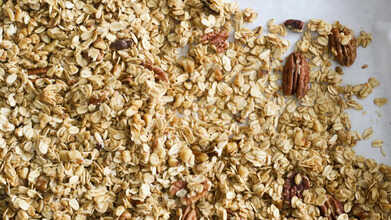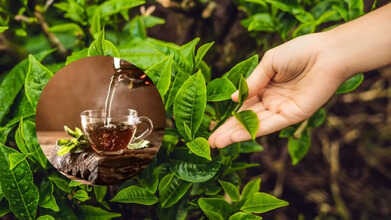- Health Conditions A-Z
- Health & Wellness
- Nutrition
- Fitness
- Health News
- Ayurveda
- Videos
- Medicine A-Z
- Parenting
- Web Stories
Foods That May Be Giving You Acid Reflux: How To Tame The Burn

Foods That May Be Giving You Acid Reflux: How To Tame The Burn
At 35, Neha often found herself ending long days with that familiar, uncomfortable burn in her chest. She loved spicy foods and an occasional late-night snack, but over time, what started as mild discomfort had turned into nightly battles with acid reflux. "I’d lie down, and that burning feeling would creep up my chest," she shared, "and sometimes it even left a bitter taste in my mouth." It wasn’t until she started learning about foods that trigger acid reflux that she realized her diet and lifestyle could be part of the problem.
Acid reflux is an uncomfortable condition that affects millions, but it’s also manageable. If your symptoms persist or worsen, consult with a healthcare professional for guidance tailored to your needs. With the right balance, you can enjoy your meals without the burn.
What Is Acid Reflux?
Acid reflux occurs when stomach acid flows back into the esophagus, leading to the burning sensation known as heartburn. Chronic acid reflux, or GERD (Gastroesophageal Reflux Disease), can also cause a range of other symptoms like regurgitation, sore throat, chronic cough, and hoarseness. The condition happens when the lower esophageal sphincter, a valve that keeps stomach acid in the stomach, doesn’t work effectively, allowing acid to escape upward. Factors like diet, weight, and certain lifestyle habits can worsen this condition.
If you’re like Neha and struggle with acid reflux, learning to spot your triggers can be a game-changer. Here are some common foods that may be responsible.
1. Caffeine
Your morning cup of coffee might be an unexpected culprit. Caffeine is known to relax the lower esophageal sphincter, making it easier for stomach acid to travel back into the esophagus. This effect isn’t limited to coffee—tea, sodas, and energy drinks can also have the same impact. If caffeine is your go-to for an energy boost, consider switching to herbal teas or water when you can.
2. Tomato-Based Foods
Tomatoes, though packed with antioxidants, are naturally acidic and can easily trigger acid reflux. Tomato-based foods, such as pasta sauces, ketchup, and salsa, can cause irritation in the esophagus and exacerbate reflux symptoms. For those with GERD, cutting back on tomatoes or choosing low-acid tomato products may bring relief.
3. Spicy and Fatty Foods
While spicy foods can bring excitement to your meals, they may also bring unwelcome symptoms. Spicy dishes stimulate the production of stomach acid and can cause heartburn, especially when consumed in large quantities. Similarly, fatty foods like fried items, cheese, and butter slow down digestion, increasing the likelihood of acid reflux. Opting for lighter, non-spicy meals can help you avoid discomfort.
4. Chocolate and Peppermint
Chocolate and peppermint may seem harmless, but they can contribute to acid reflux in certain individuals. Both have properties that relax the lower esophageal sphincter, creating an easier pathway for acid to reach the esophagus. If these are regular indulgences, it might be worth cutting back or enjoying them in moderation to see if your symptoms improve.
Simple Lifestyle Tips to Reduce Acid Reflux
Avoiding certain trigger foods is a good start, but there are also simple lifestyle changes that can help manage acid reflux more effectively:
- Track Your Triggers: Keeping a food diary can help you identify the specific foods and beverages that lead to symptoms. Not everyone has the same triggers, so pinpointing yours can make it easier to tailor your diet.
- Eat Smaller, More Frequent Meals: Eating smaller meals more often rather than one large meal can reduce pressure on the stomach and lower the likelihood of reflux.
- Walk After Meals: Light activity, such as walking, aids digestion and helps empty the stomach faster. This can reduce the chance of acid moving upward into the esophagus.
- Avoid Late-Night Eating: Give yourself at least two to three hours between your last meal and bedtime. Going to bed on a full stomach increases the chances of acid reflux as gravity no longer helps keep stomach acid down.
Portion Control
Especially during festive seasons or gatherings, it’s easy to overeat, but portion control is vital for reducing acid reflux. Smaller portions allow time for proper digestion, minimizing the amount of acid that can escape upward. This practice also makes it easier to keep track of your intake and avoid overfilling your stomach.
Disclaimer: This article is for general information purpose only, it is not a substitute for professional medical advice. Please consult a healthcare provider for personalized guidance.
What Is Colloidal Oatmeal And How Can It Help Manage Eczema?

Credits: Canva
For many people, eczema is more than dry, itchy skin; it’s an ongoing struggle that affects overall well-being, including mood, social life, and sleep. Parents of children with eczema often spend nights trying to stop persistent scratching, while adults frequently feel self-conscious at work or in public when flare-ups are visible.
The condition also brings financial strain from treatments, frequent doctor visits, and emotional stress. In India, eczema is worsened by the climate, pollution, and regular use of harsh or fragranced skincare products, making sensitive skin even more prone to irritation. Gentle, science-backed care is essential, not just helpful, to manage skin conditions that affect over 30–40% of Indians.
We spoke to Dr Preethi Nagaraj, Medical Director and Senior Dermatologist at Twacha Skin and Hair Clinic, Kochi, to learn more.
What Is Eczema and Its Ripple Effects?
Eczema, or atopic dermatitis, typically appears as dry, itchy, and red patches on the skin. While some people may experience mild irritation, others face severe flare-ups that disrupt daily life. But eczema is more than a skin condition, it can affect concentration, mental health, and sleep. Dr Nagaraj explained that this can make it harder for children to focus at school and cause adults to miss work or social events. Recognizing these broader effects shifts the focus from simply treating the skin to supporting the individual as a whole.
Why the Skin Barrier Matters
The main reason eczema develops is a compromised skin barrier. A healthy barrier relies on ceramides, fatty acids, and cholesterol to retain moisture and block irritants. When ceramides are low, skin loses water quickly and becomes highly sensitive, even with regular moisturization. Genetics also play a role—about one-third of Indian children with hand eczema have filaggrin mutations, weakening their protective layer. That’s why consistent, barrier-focused skincare is essential to keep flare-ups under control.
What Is Colloidal Oatmeal?
Colloidal oatmeal is a fine powder made from whole oat kernels and is used as a skin protectant to soothe itching and irritation. It’s a recognized ingredient that hydrates skin, protects against irritants, and provides antioxidant and anti-inflammatory benefits. It can be used in bathwater or in creams and lotions, according to Healthline.
How Can Colloidal Oatmeal Help Treating Eczema
Colloidal oatmeal isn’t just a breakfast ingredient, it’s been a long-standing skin soother. It contains compounds called avenanthramides that calm inflammation and reduce itchiness. Beta-glucans form a protective layer to lock in moisture, and oat lipids help repair the skin’s barrier. Research supports these benefits: a study of over 54,000 patients found that not using oatmeal-based emollients increased the likelihood of being prescribed steroid creams by more than 21%. Another analysis showed that infants who regularly used oatmeal-based products were less likely to develop eczema. Gentle, effective, science-backed oats remain a staple for sensitive skin care.
Ceramides: Repairing What Eczema Steals
Dr Nagaraj explained that ceramides are natural skin fats that hold cells together and maintain hydration. Low ceramide levels make eczema-prone skin prone to cracking, roughness, and sensitivity to triggers. The good news? Oat oil can boost ceramide production in the skin by up to 70%. Combining ceramides with colloidal oatmeal in a moisturizer creates a powerful duo: one soothes and hydrates, while the other strengthens the skin’s protective layer.
Making Science-Backed Skincare Work Every Day
For sensitive or eczema-prone skin, Indian dermatologists often recommend gentle, fragrance-free products enriched with colloidal oatmeal. Using these regularly is preventive, not a luxury. Consistent care can mean fewer sleepless nights for families, while adults regain confidence at work and in social settings. The key to preventing flare-ups is a steady, regular routine.
Eczema can take a physical and mental toll, but it doesn’t have to control life. Colloidal oatmeal, supported by tradition and science, provides gentle, effective relief, while ceramides maintain the skin’s strength. Together, they reduce sensitivity to daily triggers and help break the cycle of flare-ups. The takeaway is simple: small, consistent steps in skincare can have a major impact. With the right approach, patients and families can reclaim comfort, confidence, and quality of life, making colloidal oatmeal a trusted ally on the path to healthier skin.
Is Bubble Tea Putting Your Health at Risk? Experts Warn About Lead Exposure

Credits: Canva
A trendy drink that’s become a social media favorite may now have fans thinking twice, after questions were raised about one key ingredient.
Bubble tea, also called boba or pearl milk tea, first appeared in Taiwan in the 1980s. It’s usually made with tea, milk or creamer, a sweetener, and, of course, the signature chewy tapioca pearls.
While its colorful, Instagram-worthy appeal has made it popular around the world, recent safety tests from Consumer Reports suggest there could be reason for concern.
Also Read: mRNA COVID Vaccines Found To Help Cancer Patients Live Longer: Can This Be The Ultimate Cancer Cure?
Boba Tea Contains Lead?
Bubble tea, the Taiwanese drink made of black tea, milk, sugar, and chewy tapioca pearls, has won fans worldwide since its debut in the 1980s. But recent findings suggest it may deserve a closer look.
A Consumer Reports investigation in the US found high lead levels in some bubble tea products, echoing earlier concerns about cassava-based foods. The tapioca pearls, the drink’s signature “bubbles,” are made from cassava starch, which can absorb lead and other heavy metals from the soil as the plant grows.
Why Are Tapioca Pearls Harmful?
Lead is naturally present in the Earth’s crust, and much of the world’s soil contains significant contamination. Many fruits and vegetables, including cassava, can absorb heavy metals during growth.
Consumer Reports tested tapioca pearls from popular bubble tea chains, Gong Cha and Kung Fu Tea, as well as packaged boba products from Trader Joe’s and WuFuYuan. Every sample contained some lead. Thankfully, none exceeded the levels that Consumer Reports considers concerning, and none had dangerous levels of arsenic, cadmium, or mercury in a single serving.
Also Read: World Polio Day: How the Polio Vaccine Became a Lifesaving Shield Against a Global Disease
“These levels weren’t high enough for us to advise people to completely avoid bubble tea,” said James E. Rogers, PhD, director of food safety research and testing at Consumer Reports.
“However, this wasn’t a comprehensive survey of the boba and bubble tea market. The fact that three out of four samples contained more than half of our level of concern for lead in a single serving is a strong reminder that bubble tea should be enjoyed occasionally, rather than as an everyday drink.”
Beyond heavy metals, the starchy composition of tapioca pearls can pose other risks. Eating large amounts may slow stomach emptying, a condition called gastroparesis, or even cause blockages. Symptoms can include nausea, vomiting, and abdominal pain, and people with already slow digestion may be particularly affected.
Bubble Tea and Kidney Health
Bubble tea can also impact kidney health. In 2023, Taiwanese doctors removed more than 300 kidney stones from a 20-year-old woman who reportedly drank bubble tea in place of water. Ingredients such as oxalate and high phosphate levels can contribute to stone formation, though this extreme case likely reflects unusually high consumption.
Jason Tsou, General Manager at WuFuYuan’s parent company, Shanghai ZhouShi Foodstuffs, said the company routinely tests its products for lead through an accredited laboratory. Following these recent findings, they have introduced stricter standards to ensure safety, as per New York Post.
Can L-Theanine Really Make You Focus Better? What Science Says About the ‘Calm but Alert’ Effect

Credits: Canva
If you often struggle with stress or restless nights, a warm cup of tea is likely your go-to for calming down. Tea’s comforting reputation isn’t just tradition, studies suggest it can support heart health, aid digestion, and more. One key component behind these benefits is L-theanine, an amino acid found in tea leaves. Available as a supplement, L-theanine is thought to help reduce anxiety, improve sleep, and even enhance focus.
It is gaining popularity as a supplement for enhancing focus and relaxation. But does it live up to the hype? Here's what recent research reveals about its effects on attention, reaction time, and cognitive performance.
What Is L-Theanine?
L-theanine is an amino acid naturally found in tea leaves, especially in green tea and loose-leaf varieties, and is believed to offer several health benefits. But first, it helps to understand what amino acids are and why they matter.
Amino acids are the building blocks of proteins and, ultimately, life itself, as per Healthline. They are molecules used by all living organisms to make proteins. Humans need 20 different amino acids to function properly, 11 of which are essential and must come from food.
Although L-theanine is not essential for survival, research has explored its effects on brain function and cognitive performance.
You can consume L-theanine by drinking teas such as green tea, white tea, or matcha, or by taking it in supplement form, including tablets and capsules.
Can L-Theanine Really Make You Focus Better?
Yes, several studies suggest that L-Theanine can enhance focus and attention. For instance, a 2011 study published in ScienceDirect found that L-Theanine improved attention performance and reaction time in individuals prone to high anxiety.
Additionally, a 2021 study in PubMed Central reported that a single dose of L-Theanine reduced reaction time to attention tasks and increased the number of correct answers in working memory tasks among middle-aged adults.
PMC
L-Theanine appears to have a positive impact on reaction time. A 2025 study published in PubMed found that a 200 mg dose of L-Theanine reduced hit reaction time by 38.65 milliseconds in sleep-deprived individuals during a traffic-related visual recognition task.
PubMed
L-Theanine Effect with Caffeine
When combined with caffeine, L-Theanine may offer enhanced cognitive benefits. A 2010 study in PubMed indicated that the combination of 97 mg of L-Theanine and 40 mg of caffeine improved accuracy during task switching and reduced self-reported tiredness in young adults.
PubMed
L-Theanine: Is It Safe to Use?
L-Theanine is generally considered safe when consumed in moderate amounts, such as those found in tea or supplements. However, as with any supplement, it's advisable to consult with a healthcare provider before starting, especially if you have underlying health conditions or are taking other medications.
L-Theanine shows promise as a natural supplement to enhance focus and reaction time, particularly when combined with caffeine. While more research is needed to fully understand its long-term effects, current studies suggest it can be a useful tool for those seeking improved cognitive performance without the jitteriness associated with other stimulants.
Disclaimer: The information provided is based on current research and should not replace professional medical advice.
© 2024 Bennett, Coleman & Company Limited

